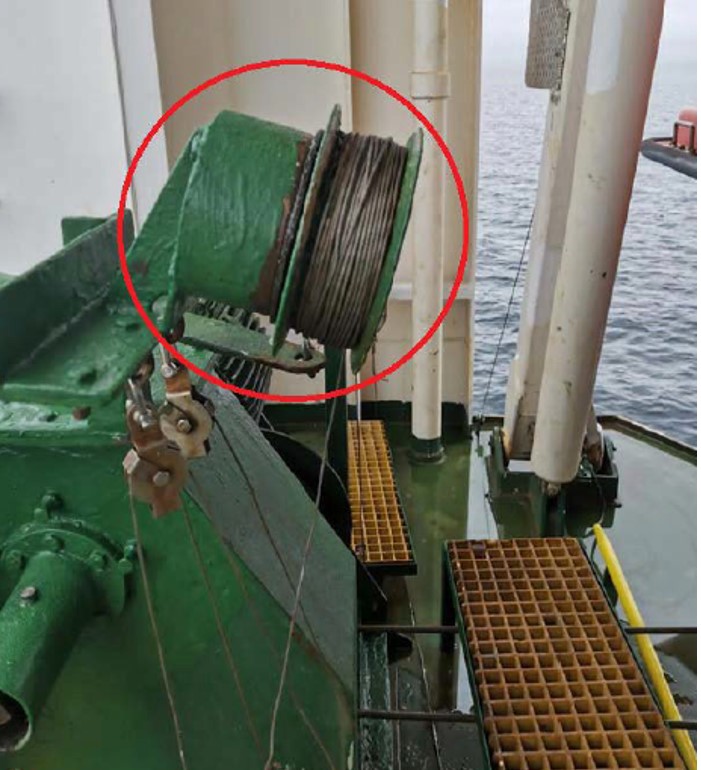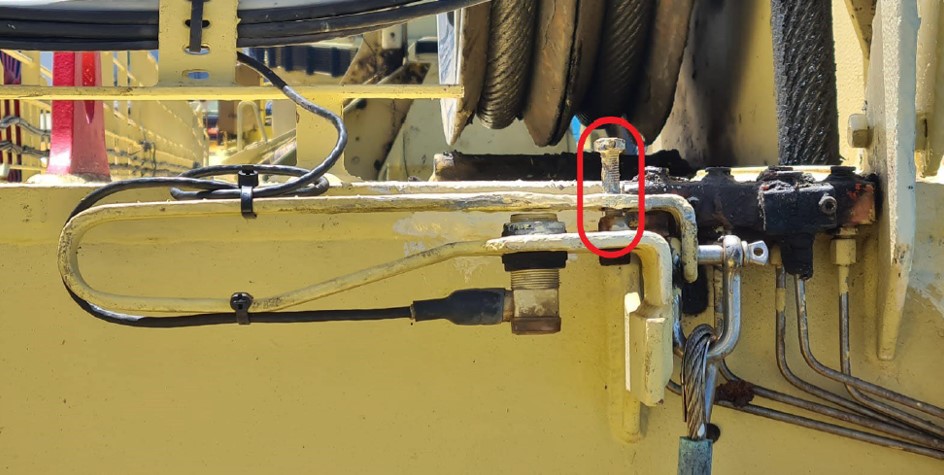Maintenance and painting – two incidents
What happened
A member reports two incidents in which something went wrong owing to failures in the maintenance process.
Incident 1: Material failure during lowering of lifeboat
During lowering of a lifeboat, a small shackle broke. The shackle held the upper sheave guiding the brake release wire, resulting in the sheave falling down on top of the lower sheave. This caused the brake handle not to fall into brake position, with the consequence that the lifeboat did not stop lowering but kept on going down.
What went right
The situation did not get out of control: the officer on deck took over control and applied force on the brake handle to stop the boat going any further down. There were no injuries in either incident.

What went wrong
Investigation showed that that the brake release wire drum was stuck/not turning, apparently due to there being an excessive amount of paint (see illustration) applied during the recently done maintenance. Once the paint was removed, the drum could be easily moved by hand.
Incident 2: Damaged sheave due to main hoist high hook failure
The main hoist hook block overshot the highest position alarm and ran into the sheaves from the main runner under the jib. The jib was lifted by the force of the main runner and the crane stopped automatically when the slack wire alarm of the topping wire was activated.
What went wrong
Investigation showed that one of the runner sheaves underneath the jib was bent slightly and unable to move freely. During the inspection of the high hook alarm, it was discovered that the flat bar (see illustration) in front of the sensor was not moving. It was stuck in place because of dry paint from maintenance that morning.
Further, the crane operator did not pay sufficient attention when working near the limits of the crane, not looking up to the hook.


Actions
- The damaged sheave was reshaped. Thorough examination of the sheave surface and inspection by means of dye penetration testing showed that there were no cracks;
- Ensure close monitoring the crane movements after each order given and when working near any of the crane limits;
- Test alarms after maintenance on the crane;
- After maintenance/painting check that all equipment parts are still movable and fully operational.
Members may wish to refer to:
- Oil leakage from cylinder head cover [After completion of regular planned maintenance on an engine, the cylinder covers were not mounted back correctly]
- Inadequate maintenance and securing arrangements of emergency exit hatches [“Safety inspections and maintenance of critical equipment should be conducted in an effective manner.”]
- Failure of remote control/emergency stop on rescue boat winch
- Crane whip line parted during hook stop testing
Safety Event
Published: 4 May 2022
Download: IMCA SF 11/22
IMCA Safety Flashes
Submit a Report
IMCA Safety Flashes summarise key safety matters and incidents, allowing lessons to be more easily learnt for the benefit of all. The effectiveness of the IMCA Safety Flash system depends on Members sharing information and so avoiding repeat incidents. Please consider adding [email protected] to your internal distribution list for safety alerts or manually submitting information on incidents you consider may be relevant. All information is anonymised or sanitised, as appropriate.
IMCA’s store terms and conditions (https://www.imca-int.com/legal-notices/terms/) apply to all downloads from IMCA’s website, including this document.
IMCA makes every effort to ensure the accuracy and reliability of the data contained in the documents it publishes, but IMCA shall not be liable for any guidance and/or recommendation and/or statement herein contained. The information contained in this document does not fulfil or replace any individual’s or Member's legal, regulatory or other duties or obligations in respect of their operations. Individuals and Members remain solely responsible for the safe, lawful and proper conduct of their operations.
